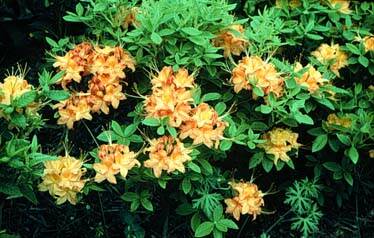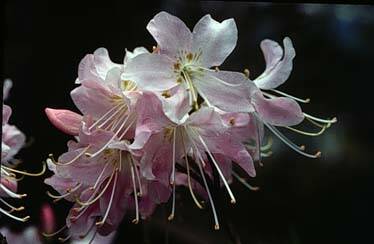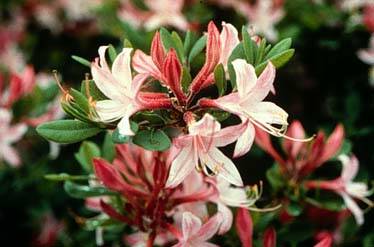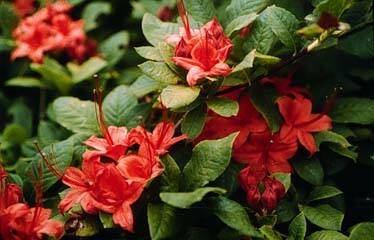Dick Bir Fletcher, North Carolina State University
Native plants have been good to me and good to the nursery and landscape industry. By the end of the year I will have spoken about native plants to groups in more than 80 percent of the states east of the Mississippi and, I hope, helped people to realize that some of our best landscape plants are native to North America, if not to their immediate neighborhoods.
Too often we forget that flowering dogwoods redbuds, live oaks and hemlocks are all North American natives and have been responsible for financial success for the green industry as well as having enhanced landscapes, improvedtheenvironment and made life better for society as a whole. Of course, the same sentence could be written about exotic plants or hybrids or clones and would be just astrue.
What people want to know

When I give native plant talks to landscape and garden groups, the plants they want to hear about most often are native azaleas.
Native azaleas are available in colors from red and pink through orange and yellow to white with infinite shades and combinations of these colors. There are native azaleas with bewitching fragrances, overpowering perfume and others with no scent at all. They will grow in swamps as well as relatively dry or sandy and clay soils. We have native azaleas in bloom from early April well into August and sometimes into September. However, they are not a common landscape item. Why?
One answer is profit. Native azaleas are not as easy to propagate as most evergreen azaleas although they can be propagated by seeds, cuttings and some by tissue culture. They require a little more attention in production and most do not fit the mass merchandising culture that has been necessary to grow and sell some plants. All native azaleas are deciduous. Most bloom a little later than the spring garden center buying frenzy and are not quite as splashy or showy (gaudy?) as their evergreen relatives from the Orient. As a result, less effort has been spent on marketing and selling these wonderful plants. However, they can be grown into beautiful plants both in the container (visit Tom Dodd Nurseries in Alabama or Transplant Nurseries in Georgia) or field (visit small nurseries scattered through the mountains of western North Carolina and eastern Tennessee).
Why grow native azaleas? Because they are terrific plants for many landscapes and they can expand your offerings at a time when something new (whether it is actually new or not) may be needed to attract customers who end up buying a lot more than native azaleas.
Not all are the same

Native azaleas are not all the same. For example, some will tolerate moist soils and others die in moist soils. Some species are native to Florida or Georgia but grow well in gardens farther north, but species from the North such as Rhodora do not move south as well. Species native to moist sites like swamp azalea, Rhododendron viscosum, will grow well on drier sites but those from drier habitats like flame azalea, R. calendulaceum, do not survive consistently soggy sites.
Whether these azaleas are "truly" or locally native may come into question. I was chastised by a woman in the audience following a recent talk at a northeastern native plants program because I suggested planting pink-shell azalea, R. vaseyi, in northeastern gardens and had the gall to show a slide of a pink-shell thriving in a Connecticut garden alongside cousins from the Orient. Pink-shell is native to only a half-dozen counties in the mountains of North Carolina.
My critic may not have known that the land on which this azalea was growing hadn't been virgin soil in centuries and was within a city where pristine coastal forests are not likely to return. Apparently she did not know that even if there were Connecticut native azaleas nearby that pink-shell would not contaminate their gene pool (a legitimate concern) since it will only hybridize with other pink-shells. She had missed or chosen to miss my point that there are terrific garden plants native to North America; some of them are azaleas and they may not find their way to your neighborhood without help.
Janet Marinelli of the Brooklyn Botanic Garden captured the essence of this argument in her new book, "Stalking the Wild Amaranth: Gardening in An Age of Extinction," when she wrote, "The real issue is not place of origin but rather behavior."
I find that most gardeners and landscapers buy plants because they are beautiful and perform well. That is why you should consider native azaleas and the question for most nurseries becomes which ones to grow, not whether they are native to where your customers live.
What a fragrance

Look at your customers and how you are going to market a native azalea as you are looking at what will be required to grow it. If both fit your nursery, then try it. Personally, I do not think we have sold some of the positive attributes of native azaleas well enough. For example, we have overlooked fragrance when marketing azaleas. The smooth or sweet azalea, R. arborescens, blooms after weather warms, usually when folks want to spend time outdoors or have windows open to enjoy soft evening breezes . Its fragrance is sweet and heliotrope-like - reason enough to place one strategically in a landscape where the white flowers can add classic elegance and alluring fragrance.
If you need a smaller native (R. arborescens can grow to 15 feet tall) with traffic-stopping bloom and superb natural perfume in mid-spring, one of my favorites is actually a clone. (This is not the place to discuss whether a clone of a native is still a native. Whether it is or not, it is a terrific azalea.) Picture a plant 4 feet high and 8 feet across with lush, blue-green leaves. Now add medium-pink flowers almost totally covering this wonderful azalea. Next, add a seductive scent and you have 'Marydel'. I have 'Marydel' growing outside my office in the southern Blue Ridge Mountains. Each spring, cars stop and we get inquiries as to what 'Marydel' is and where people can buy one.
Perhaps it would have helped if Polly Hill had chosen another name when she registered 'Marydel' in 1979. At the time she listed it as a natural hybrid of R. atlanticum (coastal or dwarf azalea) and R. periclymenoides (Pinxterbloom), which was found in the wild in Delaware near the Choptank River and the town of Marydel. When our taxonomists keyed my 'Marydel', they determined it is a pink form of R. atlanticum and found no Pinxter characteristics. This distinction may be important to taxonomists but the bottom line is that we have a terrific plant that is not, to my knowledge, in the trade.
A butterfly magnet

Another marketing perspective that seems to have been overlooked with native azaleas is that all of them attract butterflies. Some also attract hummingbirds. One of my favorite scentless native azaleas comes from the region around Georgia's Callaway Gardens and has become one of its signature plants. It is plum-leaved azalea, R. prunifolium. The flowers are orange-red to brick red and never appear in my gardens until July and sometimes extend until Labor Day. The flowers contrast beautifully with the lush, medium-green foliage and attract hummingbirds as well as any shrub in our gardens. Despite the shock value of August-flowering azaleas that are hardy to New England (some of the nicest plum-leaved azaleas I have seen were covered with flowers in August at Connecticut College in New London CT), this plant is rarely seen.
Bottom line
Many species of azaleas are native to the Eastern United States. Within this group there is incredible diversity with genetic traits that helped develop famous hybrid lines like the Exbury and Knapp Hill azaleas.
One species or another, their clones and hybrids are adapted to gardens from Boston to Florida. Which ones you should grow depends upon you, but please consider adding one to your garden.
Reprinted from NMPRO, November, 1998, with kind permission of the author.